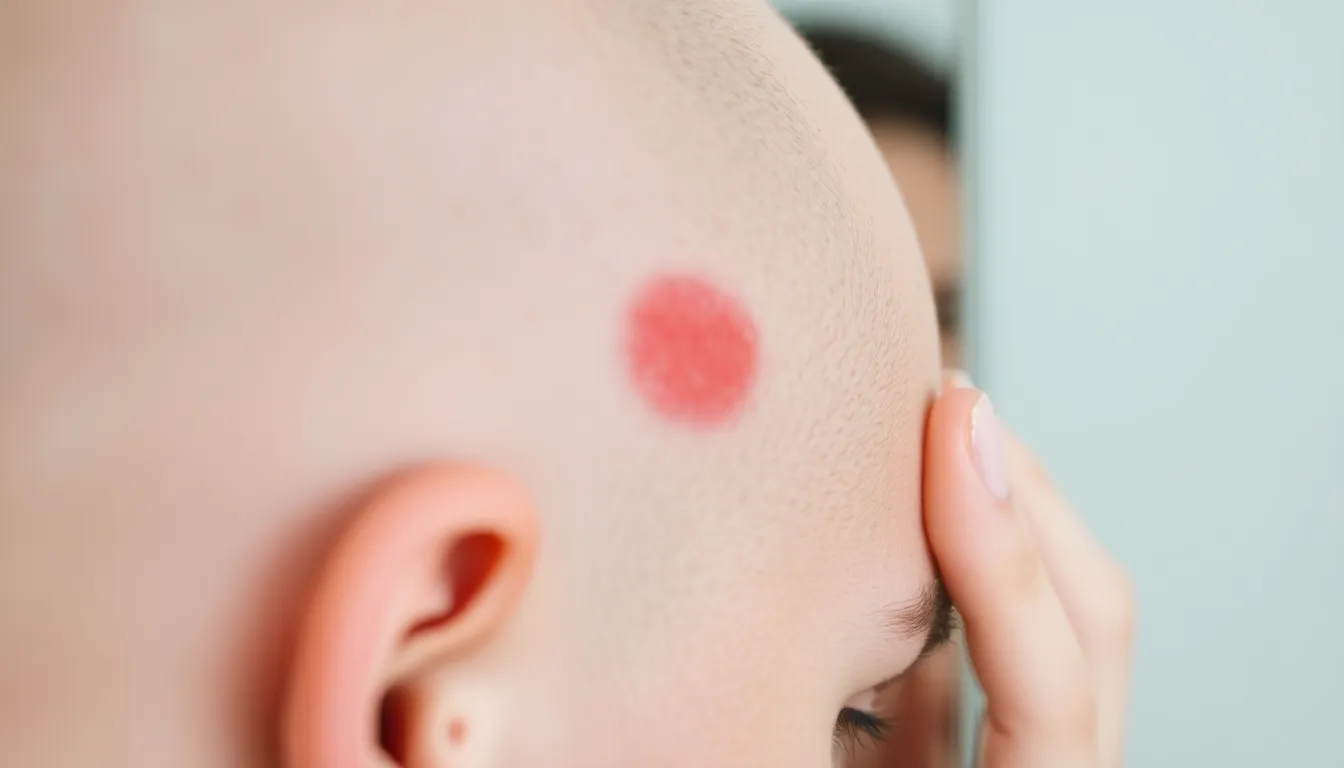A red spot on the scalp might seem like just another annoying blemish, but it could be a sign of something more serious. While most people might brush it off as a harmless pimple or a pesky mosquito bite, it’s crucial to pay attention. After all, nobody wants to play hide and seek with their health, especially when it involves potential scalp cancer.
Understanding the signs and symptoms is key to staying one step ahead. Ignoring that little red spot could lead to more than just an awkward conversation at the barber shop. So grab your magnifying glass and let’s dive into the world of scalp health. It’s time to turn that red spot into a mere memory, not a cause for concern.
Table of Contents
ToggleOverview of Red Spot on Scalp Cancer
A red spot on the scalp may indicate more than a minor irritation. Visible changes, like redness or swelling, can suggest underlying issues. Skin cancers, such as basal cell carcinoma, squamous cell carcinoma, and melanoma, often present as red or discolored spots. Monitoring the size, shape, and color of these spots becomes crucial.
Symptoms typically associated with scalp cancer include persistent itching, crusting, or bleeding. Early detection increases treatment success. Delayed diagnosis, however, might lead to more severe complications. Dermatologists recommend regular self-examinations and prompt consultations for any unusual changes.
Certain risk factors make individuals more susceptible. Sun exposure, fair skin, and a history of skin cancer elevate risk. Factors such as age and personal or family history also play significant roles. Maintaining awareness of scalp health can aid in early identification.
Treatment options for scalp cancer vary based on type and stage. Common methods include surgical excision, radiation therapy, and topical chemotherapy. Each approach targets specific cancer characteristics. Following treatment, monitoring for recurrence becomes essential.
Awareness and education about scalp health empower individuals to seek timely medical advice. By recognizing the significance of a red spot, people can prioritize their health. Heightened vigilance is vital for improving outcomes and ensuring effective care.
Types of Skin Cancer

Understanding the types of skin cancer is essential for recognizing the potential risks associated with a red spot on the scalp. Each type has distinct characteristics and implications for treatment.
Basal Cell Carcinoma
Basal cell carcinoma (BCC) represents the most common form of skin cancer. This type often appears as a pearly or domed bump on sun-exposed areas, including the scalp. It grows slowly and rarely metastasizes, but it can cause local tissue damage if left untreated. Individuals with fair skin or a history of sun exposure face a higher risk. Mohs surgery commonly treats BCC, removing the cancerous cells while preserving healthy tissue around it.
Squamous Cell Carcinoma
Squamous cell carcinoma (SCC) occurs when skin cells become abnormal, leading to a potentially aggressive cancer. Often, SCC presents as a firm, red nodule or a flat sore that doesn’t heal. Like BCC, sun exposure significantly increases risk, along with factors such as smoking and immunosuppression. Treatment typically involves surgical excision or radiation therapy, depending on the tumor’s location and stage.
Melanoma
Melanoma, the most aggressive form of skin cancer, arises from melanocytes, the pigment-producing cells in the skin. It can develop in existing moles or appear as new spots, often with irregular borders and color variations. Early detection is critical, as melanoma can spread to other body parts quickly. Treatments include surgical removal of the tumor, immunotherapy, or targeted therapies, based on the stage of cancer. Regular monitoring for changes in skin appearance is vital for prevention and timely intervention.
Symptoms and Diagnosis
Recognizing signs of scalp issues is essential for maintaining health. A red spot on the scalp may require immediate attention if it exhibits changes.
Identifying Red Spots
Red spots can vary in appearance and may indicate different conditions. Flat or raised, they could be indicative of basal cell carcinoma, squamous cell carcinoma, or melanoma. Color changes, such as becoming darker or uneven, signal potential malignancy. Spots that itch, bleed, or crust also necessitate further investigation. Monitoring size and shape remains crucial; an increase or alteration might suggest tumor growth. Early identification significantly improves treatment outcomes. Individuals should approach any of these symptoms seriously for timely intervention.
Diagnostic Procedures
Evaluating scalp conditions involves various diagnostic tools. Physicians conduct visual examinations for initial assessments. If a red spot raises concern, a biopsy is often recommended for confirmation. This procedure involves removing a small tissue sample for laboratory analysis. Additional imaging tests may be necessary to determine the extent of potential cancer. Dermatologists might also use dermoscopy, a non-invasive technique for examining skin lesions in greater detail. The more thorough the evaluation, the better the understanding of the underlying issue. Prompt diagnosis leads to more effective treatment options.
Risk Factors
Several factors contribute to the risk of developing scalp cancer. Understanding these risk factors enhances awareness and informs proactive measures for scalp health.
Sun Exposure
Prolonged sun exposure significantly increases the likelihood of skin cancer. Individuals spending more time outdoors, particularly without sunscreen or protective clothing, face heightened risks. UV rays damage skin cells, leading to mutations that can result in cancer. Regularly applying broad-spectrum sunscreen and wearing hats can reduce the chances of developing harmful skin changes. Monitoring sun exposure, especially between 10 a.m. and 4 p.m., offers additional protection against ultraviolet radiation.
Family History
A family history of skin cancer plays a critical role in personal risk factors. Individuals with relatives who have battled skin cancer may inherit genetic predispositions. This correlation emphasizes the importance of regular skin checks for those with affected family members. Knowledge of family history serves as a valuable guide for increased vigilance in self-examinations. Genetic counseling can also provide insights into risk levels and inform screening strategies tailored to individual needs.
Skin Type
Skin type is a fundamental aspect of cancer risk. Fair-skinned individuals with light hair and light eyes often possess less melanin, which provides lower protection against UV radiation. Those with this skin type should be especially cautious about sun exposure and skin changes. Darker skin types generally have greater melanin, offering some protection, but are not immune to skin cancer. Everyone, regardless of skin type, should conduct regular skin assessments and observe for unusual changes that may signal potential health issues.
Treatment Options
Treatment for red spots on the scalp varies based on the type and stage of cancer. Understanding these options helps ensure effective management.
Surgical Approaches
Surgical excision remains a common method for treating basal cell carcinoma and squamous cell carcinoma. Mohs surgery, specifically for BCC, involves removing cancerous tissue layer by layer, minimizing damage to surrounding healthy skin. For larger tumors or those in sensitive areas, more extensive procedures may be necessary. Those opting for surgery benefit from immediate assessment of the margins to confirm complete removal. Recovery times can differ based on the procedure’s complexity and individual’s healing capability.
Non-Surgical Treatments
Non-surgical treatments offer alternatives for those not suited for surgery or preferring less invasive options. Radiation therapy serves as a primary method for certain cases of squamous cell carcinoma, especially in patients who may not tolerate surgery. Topical chemotherapy, which involves applying medication directly to affected skin, can effectively target superficial skin cancers. Aside from these, immunotherapy may benefit melanoma patients, enhancing the body’s ability to fight cancer. Selecting the right treatment relies on multiple factors, including cancer type, stage, and patient health.
Conclusion
Addressing a red spot on the scalp is crucial for maintaining overall health. These spots can often signal serious conditions like scalp cancer and shouldn’t be overlooked. Regular self-examinations and awareness of changes in the skin are essential for early detection.
Understanding the types of scalp cancer and their symptoms empowers individuals to seek timely medical attention. With proper monitoring and proactive measures like sun protection, individuals can significantly reduce their risk. Prioritizing scalp health can lead to better outcomes and a more informed approach to skin wellness.




